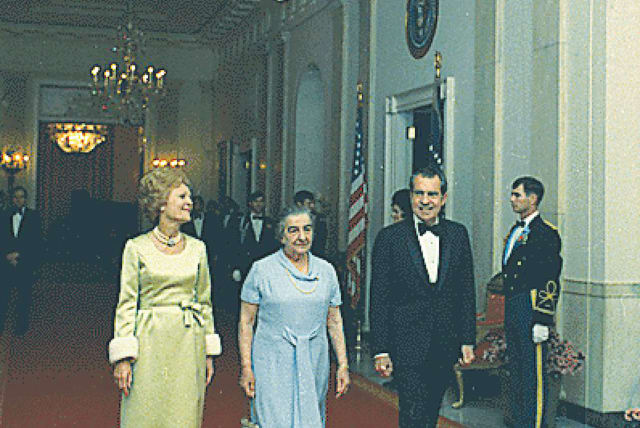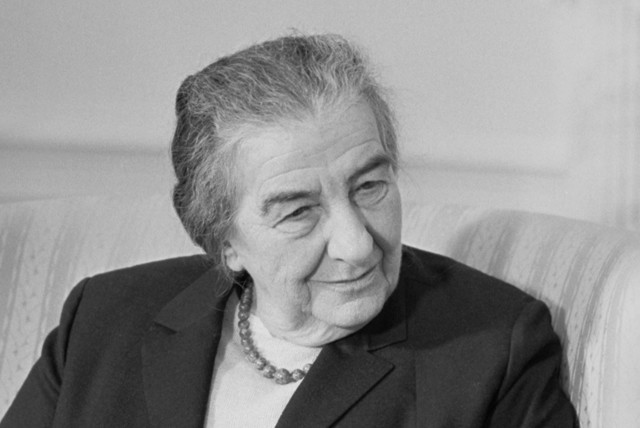In a man's world, a woman prevailed: Golda Meir, Israel's 'Iron Lady' - opinion

Despite socialist Zionism’s professed commitment to gender equality, she was nevertheless a woman in a male-dominated political world.
On June 3, 1974, Golda Meir stepped down after over five years as Israel’s prime minister. The 76-year-old Kyiv-born premier was replaced by a new Labor leader, the 52-year-old Jerusalem-born Yitzhak Rabin. Meir’s departure from national leadership appeared to signify the end of an era, the passing of the torch from the Eastern European pioneers to the younger native-born Israelis.
However, even among her generational peers, Meir remained unique. Despite socialist Zionism’s professed commitment to gender equality, she was nevertheless a woman in a male-dominated political world. And though having been born in Ukraine, from age eight Meir grew up in Milwaukee, Wisconsin, and spoke American-accented Hebrew her entire life.
Yet, Meir’s Eastern European roots were ever-present. In her autobiography My Life she recounts a formative traumatic experience: her father desperately trying to barricade the door of their home to protect the family from rampaging antisemitic pogromists.
Meir claimed that this vivid demonstration of Jewish helplessness triggered her staunch Zionism. Perhaps the childhood-learned sense of Jewish vulnerability also stayed with her even when she was the leader of a country that had become a significant military power with a purported nuclear arsenal.
Golda Meir proved her worth

Unlike many American Zionists, Meir did not remain in the US to devote her energies to Pioneer Women or Hadassah, but in 1921 immigrated to British Mandatory Palestine.
Meir settled in Kibbutz Merhavia, however, she was stereotyped as an “American princess” unsuited for the spartan pioneering lifestyle, and her first request for kibbutz membership was denied. Meir had to prove herself – laboring in the fields, working with poultry, and running the communal kitchen.
In 1924, Meir left the kibbutz and gravitated to the world of political activism, initially achieving prominence in the Na’amat Women’s Labor Movement. Her public career took off during the 1930s and 1940s and she was elected to the Executive Committee of the Histadrut Labor Federation and the Political Department of the Jewish Agency.
In the latter role, she met secretly with Emir Abdullah of Transjordan in 1947 and 1948 in an attempt to establish a modus vivendi between the nascent Jewish state and the Hashemite Kingdom. If some of the Jewish Agency’s professional Arabists were unsure about sending a woman to negotiate with a Bedouin king, David Ben-Gurion – the Agency chair and Israel’s first prime minister – trusted her ability to do the job effectively.
When Israel’s War of Independence erupted, Meir initially felt marginalized by her male colleagues. But with the Jews outnumbered and outgunned, and the fate of the Zionist project in the balance, Ben-Gurion sent Meir to the US for an emergency appeal, her mission to secure funds to purchase weapons for Israel’s defense.
Surpassing all expectations, Meir raised some $90 million, an estimated third of the total cost of the war. Ben-Gurion hailed her efforts, writing that it was a “Jewish woman who obtained the money that made statehood possible.”
In May 1948, Meir was one of only two women who, along with 35 men, signed Israel’s Declaration of Independence (the other was Rachel Cohen-Kagan from WIZO).
MUCH TO her disappointment, Meir was at first excluded from the cabinet and instead sent to the Soviet Union as Israel’s senior diplomatic emissary. At the time, Moscow was Israel’s primary supporter and it was an important posting. While her skills could have undoubtedly been better utilized in Washington, apparently foreign minister Moshe Sharett did not want the strong and independent-minded Meir to be given such a high-profile diplomatic posting.
Spending just a few months in Russia, Meir returned to Israel in March 1949 to join the cabinet as minister of labor.
In the internal government debates of the early 1950s between defense activists led by Ben-Gurion and moderates headed by Sharett, Meir was one of the activists. In June 1956, when Ben-Gurion had had enough of Sharett’s dissent, he dismissed his foreign minister and handed the portfolio to Meir.
Unlike her predecessor, Meir supported the launching of the October 1956 Sinai Campaign against Egypt (in coordination with Britain and France).
Meir was to remain foreign minister for a decade, until being replaced by Abba Eban in January 1966. Then, out of government but still of considerable influence, she served as secretary-general of the ruling Mapai (Labor) Party.
When prime minister Levi Eshkol died in office in February 1969 the public’s favorite candidates for the top job were two charismatic former generals – interim prime minister Yigal Allon and defense minister Moshe Dayan. But the two younger men came from rival wings of Labor, and party patriarchs worried about a possible split. The 71-year-old Meir was chosen as the unity candidate.
As prime minister her popularity soared. In the Knesset elections of October 1969, her Labor Alignment won a record 56 seats. And even in the elections of December 1973, held following the calamitous October 1973 Yom Kippur War, Labor was reelected with 51 MKs.
Nonetheless, her legacy as prime minister is not without blemish. Meir was blamed for fermenting the diplomatic stagnation that led to the outbreak of war in 1973 and for failing to understand the Mizrahi “Black Panther” social protestors – whom she dismissed as “not nice people.”
But while criticized for being an “obstinate grandmother” lacking empathy for those from a different background or with a divergent perspective, Meir unquestionably provided powerful and resolute leadership.
After the murder of 11 Israeli athletes at the 1972 Munich Olympic games, she ordered Mossad to hunt down and assassinate all the terrorists involved in the massacre. In the sexist language of that period, she was praised for being “the only member of the cabinet with balls.”
And Meir knew how to negotiate with hard-nosed interlocutors. Her relationship with the ever-Machiavellian US president Richard Nixon was a textbook example of international politics at the highest level.
Despite accusations of intransigence, it was Meir’s government that agreed to the August 1970 American ceasefire proposal that ended the War of Attrition along the Suez Canal. And following the Yom Kippur War, she negotiated disengagement agreements with Egypt (January 1974) and Syria (March 1974) – the former being the embryo of Egypt-Israel peace, the latter providing stability on the Golan Heights for decades to come.
Undoubtedly, Meir’s toughness served Israel well during times of crisis, of which there were many. She was renown internationally as the “Iron Lady” – years before Britain’s Margaret Thatcher was to receive the same epithet from the Soviet Union’s Mikhail Gorbachev.
The writer, formerly an adviser to the prime minister, is chair of the Abba Eban Institute for Diplomacy at Reichman University. Connect with him on LinkedIn, @Ambassador Mark Regev.
Jerusalem Post Store
`; document.getElementById("linkPremium").innerHTML = cont; var divWithLink = document.getElementById("premium-link"); if (divWithLink !== null && divWithLink !== 'undefined') { divWithLink.style.border = "solid 1px #cb0f3e"; divWithLink.style.textAlign = "center"; divWithLink.style.marginBottom = "15px"; divWithLink.style.marginTop = "15px"; divWithLink.style.width = "100%"; divWithLink.style.backgroundColor = "#122952"; divWithLink.style.color = "#ffffff"; divWithLink.style.lineHeight = "1.5"; } } (function (v, i) { });
